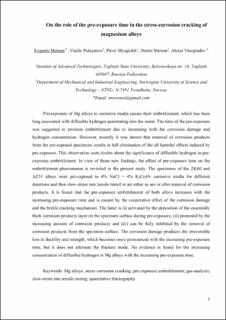| dc.contributor.author | Merson, Evgeniy | |
| dc.contributor.author | Poluyanov, Vitaliy | |
| dc.contributor.author | Myagkikh, Pavel | |
| dc.contributor.author | Merson, Dmitry | |
| dc.contributor.author | Vinogradov, Alexey | |
| dc.date.accessioned | 2022-07-05T07:24:58Z | |
| dc.date.available | 2022-07-05T07:24:58Z | |
| dc.date.created | 2021-09-29T20:30:59Z | |
| dc.date.issued | 2021 | |
| dc.identifier.citation | Materials Science & Engineering: A. 2021, 806 . | en_US |
| dc.identifier.issn | 0921-5093 | |
| dc.identifier.uri | https://hdl.handle.net/11250/3002665 | |
| dc.description.abstract | Pre-exposure of Mg alloys to corrosive media causes their embrittlement, which has been long associated with diffusible hydrogen penetrating into the metal. The time of the pre-exposure was suggested to promote embrittlement due to increasing both the corrosion damage and hydrogen concentration. However, recently it was shown that removal of corrosion products from the pre-exposed specimens results in full elimination of the all harmful effects induced by pre-exposure. This observation casts doubts about the significance of diffusible hydrogen in pre-exposure embrittlement. In view of those new findings, the effect of pre-exposure time on the embrittlement phenomenon is revisited in the present study. The specimens of the ZK60 and AZ31 alloys were pre-exposed to 4% NaCl + 4% K2Cr2O7 corrosive media for different durations and then slow-strain rate tensile tested in air either as are or after removal of corrosion products. It is found that the pre-exposure embrittlement of both alloys increases with the increasing pre-exposure time and is caused by the combined effect of the corrosion damage and the brittle cracking mechanism. The latter is (i) activated by the deposition of the essentially thick corrosion products layer on the specimen surface during pre-exposure, (ii) promoted by the increasing amount of corrosion products and (iii) can be fully inhibited by the removal of corrosion products from the specimen surface. The corrosion damage produces the irreversible loss in ductility and strength, which becomes more pronounced with the increasing pre-exposure time, but it does not alternate the fracture mode. No evidence is found for the increasing concentration of diffusible hydrogen in Mg alloys with the increasing pre-exposure time. | en_US |
| dc.language.iso | eng | en_US |
| dc.publisher | Elsevier | en_US |
| dc.rights | Attribution-NonCommercial-NoDerivatives 4.0 Internasjonal | * |
| dc.rights.uri | http://creativecommons.org/licenses/by-nc-nd/4.0/deed.no | * |
| dc.title | On the role of pre-exposure time and corrosion products in stress-corrosion cracking of ZK60 and AZ31 magnesium alloys | en_US |
| dc.type | Peer reviewed | en_US |
| dc.type | Journal article | en_US |
| dc.description.version | acceptedVersion | en_US |
| dc.rights.holder | This is the authors' accepted manuscript to an article published by Elsevier. Locked until 4.2.2023 due to copyright restrictions. | en_US |
| dc.source.pagenumber | 17 | en_US |
| dc.source.volume | 806 | en_US |
| dc.source.journal | Materials Science & Engineering: A | en_US |
| dc.identifier.doi | 10.1016/j.msea.2021.140876 | |
| dc.identifier.cristin | 1940893 | |
| cristin.ispublished | true | |
| cristin.fulltext | postprint | |
| cristin.qualitycode | 2 | |

